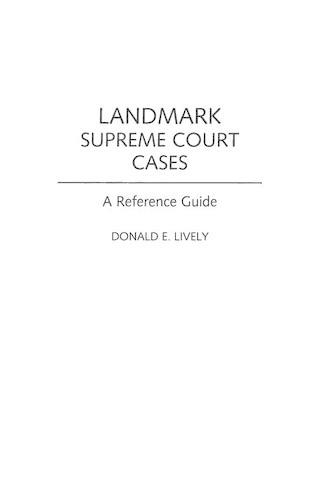
Landmark Supreme Court Cases: A Reference Guide
(Hardback)
Publishing Details
Landmark Supreme Court Cases: A Reference Guide
By (Author) Donald E. Lively
Bloomsbury Publishing PLC
Greenwood Press
30th June 1999
United States
Classifications
Tertiary Education
Non Fiction
Jurisprudence and general issues
Reference works
347.7326
Physical Properties
Hardback
384
Description
This needed resource, written specifically for students and general readers, provides accessible discussions of 74 landmark Supreme Court cases that will help students understand the cases and their importance in American history. Cases selected for this work are those in which the Supreme Court's decisions have had a profound impact on society and the future and a meaning that transcends the impact on the immediate parties. In his own words, Donald Lively, Dean of Florida Coastal School of Law, discusses the facts, background, and significance of each landmark case so that students will be able to easily understand it. Each case features a fact box for quick reference succinctly identifying the issue, year of decision, outcome, vote, and author of the opinion. The narrative discussion of each case puts it in historical perspective, examines the background and constitutional issue involved, the case itself, why it is a landmark case, and its significance and impact. A short bibliography directs readers to a more in-depth discussion of the case and issue. The work is organized topically into four parts, within which the cases are organized chronologically from the nation's first court through the 1990s so that the reader can trace the progression of the Court's thinking on the issue. Part I focuses upon the separation and distribution of powers among the branches of government. Part II consists of cases that have been crucial in determining the relationship between the nation and its states, the concept of federalism, and regulation of the country's economy. Part III deals with the most important cases involving equalityrace, gender, and fundamental rights. Part IV identifies landmark cases on individual rights and libertiesfreedom of speech, association, press and other media, religion, search and seizure, self-incrimination, right to counsel, cruel and unusual punishment, economic rights, and the right to privacy. Each part begins with an overview of the issues raised by the cases discussed. A glossary of legal terms, a table of cases, and a handy text of the Constitution will help the student researcher. This work is ideal for the high school library and classroom.
Reviews
.,."a very good resource for those interested in a user-friendly constitutional history text. It permits the reader to identify key Supreme Court cases at a glance, establish relationships between cases and development of American constitutional doctrine, within the various historical factors, political or otherwise, which impacted the decisions."-Essays in History
...a very good resource for those interested in a user-friendly constitutional history text. It permits the reader to identify key Supreme Court cases at a glance, establish relationships between cases and development of American constitutional doctrine, within the various historical factors, political or otherwise, which impacted the decisions.-Essays in History
The thematic approach combined with fairly detailed discussion of individual cases works well.-Booklist/Reference Books Bulletin
This will be a useful resource for academic and public library reference collections.-American Reference Books Annual
This will be a useful resource for serious students and researchers.-The Book Report
Perfect for high school assignments.-Pennsylvania School Librarian's Association
Perfect for high school assignments.Pennsylvania School Librarian's Association
"Perfect for high school assignments."-Pennsylvania School Librarian's Association
"The thematic approach combined with fairly detailed discussion of individual cases works well."-Booklist/Reference Books Bulletin
"This will be a useful resource for academic and public library reference collections."-American Reference Books Annual
"This will be a useful resource for serious students and researchers."-The Book Report
..."a very good resource for those interested in a user-friendly constitutional history text. It permits the reader to identify key Supreme Court cases at a glance, establish relationships between cases and development of American constitutional doctrine, within the various historical factors, political or otherwise, which impacted the decisions."-Essays in History
Author Bio
DONALD E. LIVELY is Dean of the Florida Coastal School of Law. He is author of Essential Principles of Communications Law (Praeger, 1991), Modern Communications Law (Praeger, 1991), The Constitution and Race (1992), and Foreshadows of the Law (Praeger, 1992).
